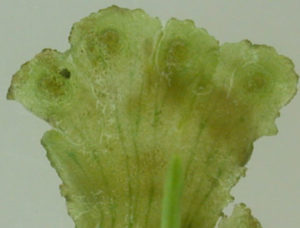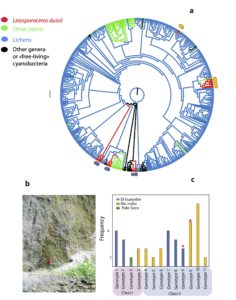
Symbioses between plants and nitrogen-fixing cyanobacteria are benchmark biological systems to understand mutualism and patterns of coevolution. The diversity of cyanobacteria associated to non-vascular land plants is still being unraveled, with a huge gap in knowledge from tropical areas, especially in hornworts. Hornworts are arguably the oldest land plant lineage with a widespread symbiosis with cyanobacteria (Villarreal & Renzaglia 2015).
We focus on the Neotropical hornwort Leiosporoceros dussii, which has a semi-permanent association with cyanobacteria. Unlike other hornworts, the peculiar Nostoc canals suggest cyanobiont specificity and selectivity.
In this study, we characterized the bacteriome and focus on the endophytic cyanobacteria by describing its morphology, metagenomic diversity and phylogeny between two sampling sites in Panama. First, we use a metagenomic analyses (16S) from gametophytes from Río El Guayabo and Río Indio in Panama to identify the endophytic bacteria community of L. dussii. To provide more information on the cyanobacterial endophytes, we have extracted cyanobacterial endophytes to measure cell size variation and use the markers trnL and rbcLX to determine their phylogenetic relationships.
What are our main findings?

We found little diversity in Leiosporoceros bacteriome but observe significant community variations between sites. Besides the expected Nostoc, the unexpected Gloeobacter (Cyanobacteria) we found abundant Proteobacteria, Rhizobiales. Caulobacter among others. Using a extensive rbcLX dataset published by Magain et al. (2017), we found a lack of cyanobacterial specificity, with six unrelated clades of Nostoc associated with Leiosporoceros.
This study provides the first hornwort bacteriome and is an important step in the characterization of tropical bryophyte symbioses.
We thank Karen Renzaglia for her initial encouragement (to JCVA) to study the Leiosporoceros symbiosis (in 2004) and Nicolas Magain for sharing his published rbcL-X matrix.
Bouchard, R., G. Peñaloza-Bojacá, S. Toupin, et al. 2020. Contrasting bacteriome of the hornwort Leiosporoceros dussii in two nearby sites with emphasis on the hornwort-cyanobacterial symbiosis. Symbiosis. pdf